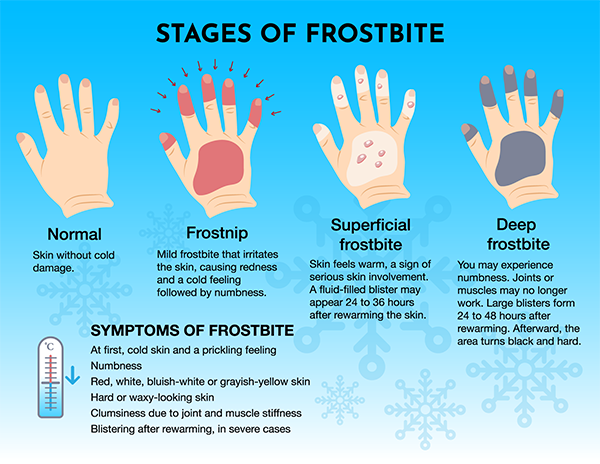Mild Hypothermia
Someone suffering from mild hypothermia may exhibit one or more of these symptoms:
- Shivering
- Cold, pale, or blue-gray skin
- Lack of interest or concern (apathy)
- Poor judgment
- Mild unsteadiness in balance or walking
- Slurred speech
- Numb Hands and fingers
- Problems performing tasks
First Aid for Mild Hypothermia
- Call 911 (conditions can quickly deteriorate)
- Move the person to a warm, dry area
- Remove wet clothing, shoes, and socks
- Have the person lay down and cover them with layers of blankets or towels. Place a vapor barrier, such as a plastic bag, over the person making sure to keep it free from the face
- If alert, offer a warm (not hot) non-alcoholic beverage
- Place warm bottles, hot packs, or hand warmers in armpits, groin area, and along the sides of the chest.
Severe Hypothermia
Someone suffering from severe hypothermia may exhibit one or more of these symptoms:
- The trunk of the body is cold to the touch
- Muscles become rigid
- Pulse rate is slow
- Breathing is slow and shallow
- Weakness or sleepiness
- Confusion
- Loss of consciousness
- Shivering may stop if body temperature drops below 90°F
First Aid for Severe Hypothermia
- Call 911 (This is a Medical Emergency)
- Continue to monitor breathing. Begin CPR if necessary
- Move the person to a warm, dry area
- Have the person lay down and cover them with layers of blankets or towels. Place a vapor barrier, such as a plastic bag, over the person making sure to keep it free from the face
- DO NOT try other rewarming techniques unless instructed to do so by 911 dispatch. Rewarming too rapidly can cause cardiac arrest.
Immersion Hypothermia
Water temperatures below 70°F or below can cause immersion hypothermia. Water conducts heat away from the body 25 times faster than air and wind alone.
These symptoms can be those of mild or severe hypothermia. Treat the same as severe hypothermia.
First Aid for Immersion Hypothermia
- Call 911 (This is a Medical Emergency)
- Continue to monitor breathing. Begin CPR if necessary
- Move the person to a warm, dry area
- Remove wet clothing, shoes, and socks
- Thoroughly dry the person
- Have the person lay down and cover them with layers of blankets or towels. Place a vapor barrier, such as a plastic bag, over the person making sure to keep it free from the face
- DO NOT try other rewarming techniques unless instructed to do so by 911 dispatch. Rewarming too rapidly can cause cardiac arrest.
Frostbite
Frostbite is an irreversible condition in which ice crystals form between cells causing the skin to freeze.
Symptoms include:
- Numbness in the affected area
- Tingling or stinging in the affected area
- Red, white, bluish-white, or grayish skin with hard or waxy looking skin
- Clumsiness due to joint and muscle stiffness
First Aid for Frostbite
- Move the person to a warm place
- Seek medical attention
- Remove constrictive clothing and jewelry that could impair circulation
- Place dry, sterile gauze between fingers and toes to absorb moisture
- Elevate the affected area to reduce pain and swelling

